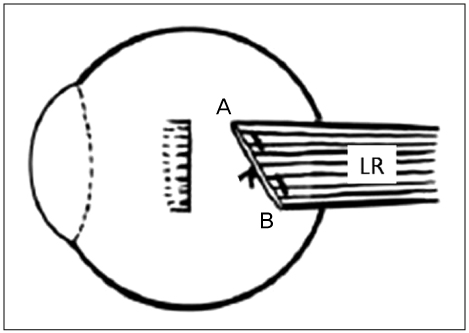J Korean Ophthalmol Soc.
2012 Feb;53(2):311-315.
The Effect of Bilateral Slanted Lateral Rectus Recession in Exotropia with Near-Far Disparity
- Affiliations
-
- 1Department of Ophthalmology, Busan Paik Hospital, Inje University College of Medicine, Busan, Korea. judysg@daum.net
Abstract
- PURPOSE
To evaluate the efficacy of slanted recession of the lateral rectus (LR) muscle for exodeviation with larger deviation angle at near than far fixation.
METHODS
A retrospective chart review was conducted of 31 patients. Seventeen patients underwent slanted LR recession, the upper fiber of the LR was recessed according to the distance deviation angle and the lower fiber was recessed according to the near deviation. Fourteen patients underwent classic recession. To evaluate the effect of slant LR recession, postoperative ocular alignment between them was checked at 1 week, 1 month, 3 months and 6 months after operation.
RESULTS
At the postoperative 6 months, bilateral slanted LR recession reduced the mean exodeviation at near from 33.82 PD to 7.29 PD, and same amount recession group reduced 33.67 PD to 11.13 PD. The far deviation change was from 25.59 PD to 2.59 PD, 23.67 PD to 4.00 PD in each group. The change of near-distance difference was from 10.29 PD to 4.71 PD in slanted recession group, and 9.67 PD to 7.93 PD in same amount recession group, showed that slanted recession group reduced angle more significantly (p = 0.002). Success rate was 35% in bilateral slanted LR recession group, 7% in classic recession group, showed that slanted recession group had significantly high success rate (p < 0.05).
CONCLUSIONS
Bilateral slanted LR recession effectively reduces near and distance exodeviation angle, and reduces near-distance incomitance more superior to classic bilateral LR recession technique.
MeSH Terms
Figure
Reference
-
1. Kushner BJ. Selective surgery of intermittent exotropia based on distance/near differences. Arch Ophthalmol. 1998. 116:324–328.2. von Noorden GK. Resection of both medial rectus muscles in organic convergence insufficiency. Am J Ophthalmol. 1976. 81:223–226.3. Kraft SP, Levin AV, Enzenauer RW. Unilateral surgery for exotropia with convergence weakness. J Pediatr Ophthalmol Strabismus. 1995. 32:183–187.4. Daum KM. Convergence insufficiency. Am J Optom Physiol Opt. 1984. 61:16–22.5. Birnbaum MH, Soden R, Cohen AH. Efficacy of vision therapy for convergence insufficiency in an adult male population. J Am Optom Assoc. 1999. 70:225–232.6. Choi DG, Kim PS. The surgical outcome of intermittent exotropia and the prognostic factors. J Korean Ophthalmol Soc. 1998. 39:1255–1263.7. Hermann JS. Surgical therapy for convergence insufficiency. J Pediatr Ophthalmol Strabismus. 1981. 18:28–31.8. Haldi BA. Surgical management of convergence insufficiency. Am Orthopt J. 1978. 28:106–109.9. Raab EL, Parks MM. Recession of the lateral recti. Effect of preoperative fusion and distance-near relationship. Arch Ophthalmol. 1975. 93:584–586.10. Choi MY, Kim EK, Hwang JM. The prospective comparison of surgical outcomes in convergence insufficiency exotropia. J Korean Ophthalmol Soc. 2004. 45:1699–1707.11. Park JS, Lee SJ, Roh YB, Choi HY. Monocular slanted lateral rectus recession for exotropia with convergence insufficiency. J Korean Ophthalmol Soc. 2007. 48:1112–1118.12. Parks MM. Ocular Motility and Strabismus. 1975. Hagerstown, MD: Harper&Row;99–111.13. Burian HM. Exodeviations: their classification, diagnosis and treatment. Am J Ophthalmol. 1966. 62:1161–1166.14. Burian HM, Franceschetti AT. Evaluation of diagnostic methods for the classification of exodeviations. Trans Am Ophthalmol Soc. 1970. 68:56–71.15. Archer SM. The effect of medial versus lateral rectus muscle surgery on distance-near incomitance. J AAPOS. 2009. 13:20–26.16. Scott AB. Lennerstrand G, Bach-y-Rita P, editors. Strabismus muscle forces an innervation. Basic Mechanisms of Ocular Motility and Their Clinical Implications. 1975. 1st ed. New York: Pergamon press;181–191.17. Snir M, Axer-Siegel R, Shalev B, et al. Slanted lateral rectus recession for exotropia with convergence weakness. Ophthalmology. 1999. 106:992–996.18. Nemet P, Stolovitch C. Biased resection of the medial recti: a new surgical approach to convergence insufficiency. Binocul Vis Strabismus Q. 1990. 5:213–216.19. Choi MY, Hwang JM. Unilateral resection-recession based on near/distance deviation in children with exotropia of the convergence insufficiency type. J Korean Ophthalmol Soc. 2005. 46:1669–1674.
- Full Text Links
- Actions
-
Cited
- CITED
-
- Close
- Share
- Similar articles
-
- Comparison between Down Transposition and Slanted Surgery for Bilateral Lateral Rectus Recession in Convergence Insufficiency-Type Exotropia
- The Effect of Bilateral Slanted Lateral Rectus Recession in Exotropia with Near-Far Disparity
- Effects of Bilateral Lateral Rectus Recession and Unilateral Recession-Resection in Large Angle Exotropia
- Long-term Results of Slanted Recession of Bilateral Lateral Rectus Muscle for Intermittent Exotropia with Convergence Insufficiency
- Comparison of Surgical Results Between Bilateral Recession and Unilateral Resection-Recession in Intermittent Exotropia


